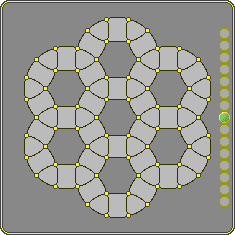Page 13 of 33
Lotus
Rules
 |
|
Komi is a way of settling the first player's advantage. Many games would be needed to establish a reliable number.
Indicating komi is not the marker's primary function - it is there because refraining from putting a stone on the board at one's turn earns a point, indicated by moving the marker.
- Players move in turn. Black moves first. A move consists of placing a stone on a vacant point.
Moving is not compulsory: a player may pass his turn without losing the right to move on his next turn. - If a player passes his turn, he moves the marker one point towards him. The player at whose side the marker is at the end of the game, receives the corresponding number of points in addition to the points he has on the board.
- A group consists of a single stone or several connected stones of the same color. The liberties of a group are the stones that border on vacant points. The stones in a group share the group's liberties.
- A group lives unconditionally if it contains a lotus - six stones around one of the boards seven hexagons. A group without a lotus lives as long as it has at least one liberty.
Capture
Assuming none of the groups involved is protected by a lotus, a move may result in:
 |
|
Lotus and its ancestor Medusa are featured in R. Wayne Schmittberger's 'New Rules for Classic Games' (John Wiley & Sons, Inc. New York; ISBN 0-471-53621-0).
Lotus © MindSports
No applet
